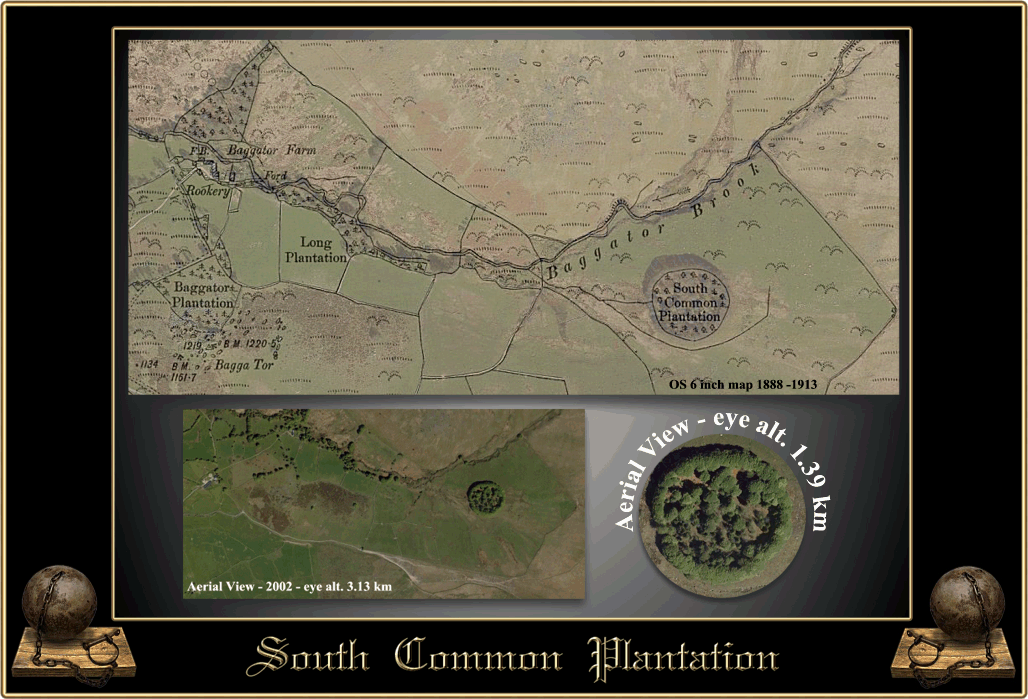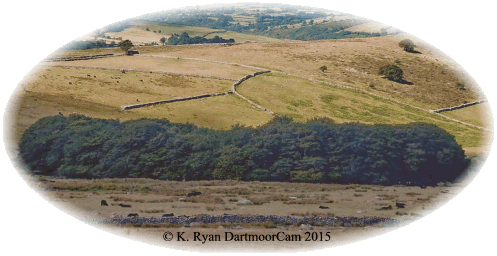
A few weeks ago I received the following email from Mike Rhodes: “Dear Tim, Firstly thank you for your excellent website. As a Devonshire lad I have long been fascinated by Dartmoor and reading your material brings back happy memories of stories told while camping for Ten Tors and letterboxing. I wondered if you have any information about the South Common Plantation (SX55686 80640). Having walked there and having observed it from the air it is such a striking feature and yet I can’t find out when it was planted or by whom. Is it associated with the military range or is it part of a more ancient feature? I would love to know more.”
Now anybody who has walked along the track towards Lynch Tor will have spotted the iconic circular wood located in the Baggator enclosure. As far as I know it is only one of two such small, man made, circular plantations on Dartmoor, the other being Hangerdown Clump on the southern moor. Now I must admit when strolling by the plantation I had never given the landscape feature much thought. However, following on from Mike’s email I did dig a little deeper with not a lot of success. It appears that Mike also did some more research and came up with a couple of interesting facts about the plantation – more of which later on.
The small plantation known as South Common Plantation takes it’s name from the enclosure in which it sits – South Common which as can be seen is the largest of the Baggator newtakes. More aptly it does sometimes go under another name; Round Wood. There can be no question that the ‘Round Wood’ is a prominent landscape feature as it can be seen from such places as Gibbet Hill which is about 3.5 km away to the west.
None of the noted topographical writers give much information regarding the plantation or as to when it was built. William Crossing does note that: “…we find ourselves in a large stroll, formed by the walls of the Bagga Tor enclosures on the left, and those of Longebetor on the right. At the other end of the stroll a large bush will be observed in the corner of the Baggator newtake, and which may be seen, is protected by a wall built across the corner. Another will be observed in the corner towards the north, and this is similarly fenced against the cattle. These shrubs were brought from abroad, and were planted here more than sixty years ago,”, p.34. Hemery has just a little to say on the matter apart from: “Bagga Tor Newtake, formerly known as ‘South Common’… the wall of ‘South Common Plantation’: the name is not used on Dartmoor, where it is known as ‘Round Wood‘,”, p.943. So without looking at any earlier maps and consulting the Tithe maps it is impossible to say who built the wood and when. It is interesting to see on the old OS map overlaid with an aerial photograph opposite how little the area has changed over the 100 or so odd years.

There is one vague train of thought, as Crossing mentions that the ‘shrubs’ were planted ‘sixty years’ previous and he was writing that around 1909. That would place the shrub planting around 1849, so in theory if those shrubs were ‘brought from abroad’ would than not suggest somebody was partaking in a spot of landscape gardening? If so, could it be that as part of that project South Common Plantation was built and populated with trees? Clearly a lot of effort had gone into its construction as the aerial picture shows an almost perfect circle.
Today the plantation lies just within the Merrivale Range and therefore does come under the auspices of the Ministry of Defence Training areas. Under the 2011 – 2020 Action Plan the MOD have under the Estate Management 2 proposal suggested that between 2013 and 2016 the plantation is restocked with native trees and the surrounding fencing repaired.


As mentioned above, Mike also found a newspaper report which appeared in, of all places, The New Zealand Herald in 1901. The article was about an escapee from Dartmoor Prison who was recaptured in what was described as a “small piece of plantation.” which belonged to Bagga Tor farm. A quick delve through The Times Newspaper archives turned up a couple of more reports on the incident. However, there is a slight problem, if you look at the map extract opposite you will see that there are four plantations surrounding Bagga Tor Farm; Long Plantation, Baggator Plantation, an unnamed plantation and South Common Plantation. Although it cannot be proven the very nature of the wording; “small piece of plantation,” could suggest South Common Plantation as it’s definitely the smallest of the four. If so then the following story has its ending in Round Wood.
On the 1st of November 1901 a large gang of prisoners were working in a turnip field belonging to the prison. At the end of the day the whistle was blown signalling for them to stop work at which point two of the convicts made good their escape. As they fled Assistant-Warder Cockshead loaded his rifle and shot down one of the escapees. Whilst this distraction was going on another three prisoners took advantage of the situation and also made a run for it. However, Cockshead managed to leap a wall and apprehend those three men whilst other warders and guards managed to contain the rest of the party. This left one prisoner; Arthur Yaxley making his bid for freedom. It did not take long for the warning to get around the neighbourhood that a prisoner was on the run. Meanwhile mounted men were sent out to watch the roads as it was supposed this would be the most logical route to take. It did not take long for the search party to find Yaxley’s waistcoat thrown down beside the road. This suggested that the convict had made off across the moor in the direction of Tavistock. Assuming a fairly direct and at times boggy route Yaxley would have travelled about 5 kilometres to the Bagga Tor enclosures where he took refuge.
Between 7.00 and 8.00pm in the evening the son of farmer Yeo from Bagga Tor Farm was walking across the newtake when his dog suddenly began barking at something in the plantation. The son knew there was a convict on the loose and so send the dog to investigate. No sooner had it entered the wood than a man shot out and made off across the field. The son blew his whistle which summoned his father and two brothers and so the posse gave chase. Eventually the man gave himself up as he could run no further and lo and behold it was Yaxley. The prisoner was the escorted back to Bagga Tor farm by his guard of moormen where he was given a meal and drink. In the morning he was carted (literally) back to Princetown where he rejoined his fellow prisoners. A later examination revealed that Yaxley had in fact been hit by one of the shots fired during the initial escape attempt. Depending whether you believe the report in The Times or the New Zealand Herald he was actually hit in the cheek. Apparently after the event the warders complained that the cartridges with which they had been issued were practically useless due to the weak charges of powder in them. This was rather fortunate for the escapees as if not so some of them would have been killed.


Crossing, W. 1914. A Guide to Dartmoor – Part II, Exeter: A. Wheaton & Co. Ltd.
Hemery, E. 1983. High Dartmoor. London: Robert Hale Ltd.
My thanks goes to Mike Rhodes for passing on his researched information.
 Legendary Dartmoor The many aspects past and present of Dartmoor
Legendary Dartmoor The many aspects past and present of Dartmoor

I’ve been fascinated by all the tales and information from this site. I was particularly intrigued by these round woods.
Upon this I found myself scouring google earth over Dartmoor.
You say you have only discovered two. This at round wood and at hanger down clump…
I’m not sure but if you google earth around bellever forest (N) postbridge(east)you can see a round patch of trees. There are in fact 2 but one being just as circular as the previously discovered…
I don’t know for sure but from what I’ve learned from this site it seems it’s worth investigating